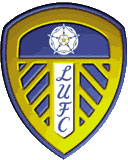 |
 |
 |
Tom Coombs never actually served as chairman
of Leeds City, though when Norris Hepworth
died in February 1914, 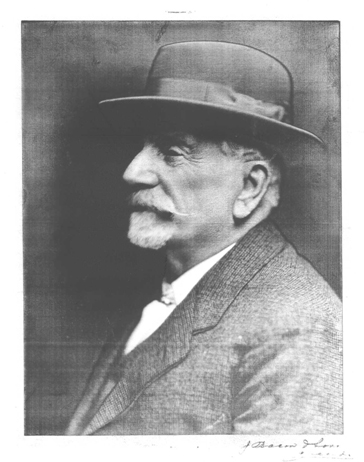 in
all but formality the accountant fulfilled the role. He kept the club
ticking over until a syndicate headed by Joseph Connor assumed control
in August 1915.
in
all but formality the accountant fulfilled the role. He kept the club
ticking over until a syndicate headed by Joseph Connor assumed control
in August 1915.
Thomas Coombs was born in Bury, Lancashire, in 1848. After qualifying as a chartered accountant, Coombs founded the firm, Thomas Coombs and Son, in 1878 in Bramley and later opened a second office in Leeds.
Among other business services, the firm acted as liquidator and receiver for organisations and it was in this role that Coombs became involved with Leeds City in 1912.
The club had always struggled to make ends meet financially and had reached a point of no return.
On 27 March 1912, the club's solicitors issued this notice: 'We beg to inform you that this morning Mr Norris Rhodes Hepworth has appointed Mr Tom Coombs, of 14 King Street, Leeds, accountant, as receiver on behalf of the debenture holders of the Leeds City Association Football Club Company Limited. The appointment was served this morning on the club by Mr R Agar Chadwick, solicitor, on behalf of Mr Hepworth and Mr Coombs. Under the appointment all the assets of the club will now belong to Mr Coombs, on behalf of the debenture holders, to whom all moneys must be paid and without whose authority no money belonging to the club can be paid.'
The Yorkshire Post reported: 'The appointment of a receiver does not mean that the club will be wound up. In a playing sense the position of the club is deplorably low, and there is at present a grave danger that it may be necessary to apply for re-election to the Second Division of the Football League. No doubt is held that in such an event re-election would be forthcoming, but apart altogether from this aspect of the situation it is felt by the responsible directors of the club that the financial affairs of the company should be straightened out and a fresh start made. At the commencement of the present football season it was stated that the indebtedness of the club to Mr Norris Hepworth, the chairman, was £10,733, and that the club's total indebtedness to all sources at that date was £13,297.
'Mr Hepworth is still the principal creditor of the club, and holds the bulk of the debentures. It is understood that a scheme of reconstruction is in contemplation, and that the ultimate result will be to give the club a fresh and more prosperous lease of life.'
Coombs' remit was to bring strict discipline to Leeds City's financial dealings while the accountant and others sought a more fundamental solution. He had the required impact.
In 1911/12 the club sustained a loss of £1,803; though the loss for 1912/13 was a near record £1,865, that figure resulted mainly from Coombs providing new manager Herbert Chapman with the funding to sign four international players. These included Bradford City captain and FA Cup winner Jimmy Speirs, who cost the Peacocks a club record £1,400. In 1913/14, the club returned a profit of £383, their first surplus since 1906.
One of the most proactive of those seeking
an escape route for the club was Alf Masser, elected to the board of directors
following a protest by shareholders in 1910. In April 1912, Masser brought
forward refinancing proposals which involved the issue of new share capital.
These were welcomed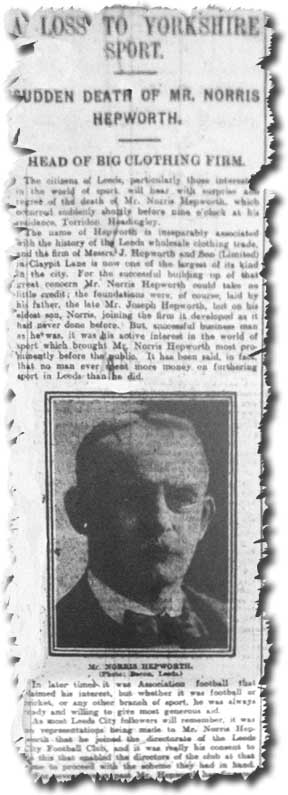 by Coombs, who moved that 'This meeting heartily endorses the scheme of
reconstruction put forward by Mr Masser and pledges itself by all means
in its power to assist in raising the necessary funds to place the club
in a sound financial position.'
by Coombs, who moved that 'This meeting heartily endorses the scheme of
reconstruction put forward by Mr Masser and pledges itself by all means
in its power to assist in raising the necessary funds to place the club
in a sound financial position.'
On 20 August 1912, the club held an Extraordinary General Meeting at the Salem Hall in the city to consider a resolution to wind up the company.
Coombs presented a statement of assets and liabilities to the shareholders. The total liabilities, including share capital, were £15,782 5s 10d. The assets consisted chiefly of ground improvements, amounting to £7,000. The position of the company was such that if the assets were good, there would still be a deficiency of £8,364. If the company ceased to exist altogether the £7,000 expenditure on the ground would be useless as an asset and there would then be a deficiency of £15,400.
The meeting was called with the object of asking the shareholders to pass a resolution, a first step towards terminating the receivership and placing the club in voluntary liquidation. This would allow a new start, with the reconstruction of the company on such lines as would satisfy the creditors, the Football Association and the Football League.
It was proposed that a new company would be formed with a nominal capital of £7,000, 1,000 of which were preference shares and the balance being 6,000 ordinary shares of £1 each. The new company would purchase the whole of the old company's assets. As the £1,000 of preference shares would be the only cash at once forthcoming, it was proposed to issue £9,000 worth of debentures to cover the balance of their liabilities.
During the course of the meeting, Alf Masser emphasised how much they were all indebted to Coombs for the 'businesslike way in which he had tackled the affairs of the club'. In issuing a thousand preference shares, he did not think they were asking for enough money, seeing that the new company would start with a liability of something like £2,500 incurred during the previous few months. Masser moved that the company be voluntarily would up, and that Coombs be appointed liquidator to preside over the arrangements.
The resolution, seconded by outgoing manager Frank Scott-Walford, was carried, but it didn't provide a lasting solution to the club's financial difficulties and they tottered on, continuing to live a hand to mouth existence.
Things became even grimmer when Chairman Norris Hepworth died in February 1914. That left Coombs in full control of running the club's affairs and desperately seeking to find a way forward. The cause was not helped by the onset of war a few weeks prior to the 1914/15 season.
The club limped through that campaign, generating a loss of £1,568, and it was clear that, deprived of the ongoing financial backing of Hepworth, they could not survive much longer without dramatic action.
Coombs negotiated a radical arrangement which he believed would save the club.
On 2 August 1915, the Leeds Mercury reported: 'Sensational rumours are current in connection with the Leeds City and Leeds Northern Union clubs. The Leeds City organisation, as is well known, is in the hands of an official liquidator, who has run the club since the death of Mr Norris Hepworth, and in effect rumour suggests that the Northern Union club are contemplating a change from Rugby to soccer, and are considering the question of purchasing the Leeds City Club lock, stock and barrel, and transferring to Headingley.'
Tom Coombs denied the reports, but the following day the Mercury continued with its story. 'The rumour of a proposed transference of the Leeds City Association Football Club from the Elland Road ground to Headingley … has caused a sensation in Leeds soccer and Northern Union circles.
'The management of the City Club, of course, has for a long time been in the hands of Mr Herbert Chapman and Mr Tom Coombs, the Official Liquidator. It must be acknowledged that membership of the Second Division of the League is not so great an asset as it was. When the war is over, and professional football is resumed, however, the League membership will be valuable again, and the players will be an asset, although not so great as asset as they were.
'The position so far as the Headingley people are concerned is that they may buy Leeds City's fixtures at Elland Road, stands, etc, if they care to take them, and they would get the League rights in the players on Leeds City's books, plus, of course, the position in the Second Division of the League - if the League sanctioned the transfer.
'Given that necessary sanction, the Northern Union game would be banished from Headingley and soccer would be played instead. The Elland Road ground would become wasteland for the time being, and its future would be a matter of doubt.
'People may ask, "What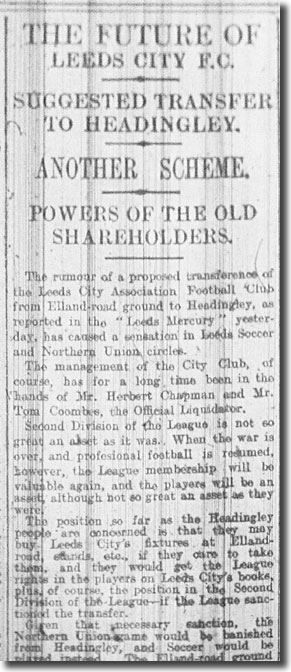 about the Leeds City shareholders?" The answer is that in the circumstances
the Leeds City shareholders do not exist. They have lost their money,
and they have no legal right to say a word concerning the future of the
club. Fortunately for them there is a distinct chance that the Management
Committee of the League would take the view that the Leeds City shareholders
have some moral right in the matter, and they may ask the Liquidator to
call a meeting of the old shareholders and ask for their views before
disposing of the club to anyone.
about the Leeds City shareholders?" The answer is that in the circumstances
the Leeds City shareholders do not exist. They have lost their money,
and they have no legal right to say a word concerning the future of the
club. Fortunately for them there is a distinct chance that the Management
Committee of the League would take the view that the Leeds City shareholders
have some moral right in the matter, and they may ask the Liquidator to
call a meeting of the old shareholders and ask for their views before
disposing of the club to anyone.
'The Liquidator need not call such a meeting unless he chooses, but his refusal to do so might be followed by the refusal of the Management Committee of the League to sanction the transfer of the club. In that case the Leeds City Club would still exist, but its membership of the League would be gone, and it would have no claim to transfer rights in the players.
'It appears that, apart from the Headingley suggestions, there is another scheme afoot to save the Leeds City Club. Several Leeds sportsmen, who desire to see the club take its place eventually in the First Division, have offered to buy the Liquidator out at the assessed value of the team and the position in the League. They have offered, it is said, to lease the Elland Road ground with an option to purchase the ground outright at any time during the next ten years. Compulsory purchase of the ground at the end of ten years has been suggested to them by the Liquidator, but they are not prepared to bind themselves to that in the present unsettled state of affairs. So far the offer of these Leeds sportsmen has not been accepted.
'Apparently, in view of the attitude of the Management Committee of the League, the old shareholders of the club can play a very large part in settling the future of the club. It should be understood that the Management Committee can refuse to allow the Leeds City headquarters to be removed from Elland Road to Headingley so long as Leeds City remain members of their body. The question last cropped up in League football when Woolwich Arsenal removed from Woolwich to North London, and it was pointed out then that there was nothing to prevent Woolwich moving to Manchester if they cared, and continuing their membership of the League there.
'To prevent the obviously possible abuse of such a state of affairs it was decided that the Management Committee have power in future to veto any proposed transfer of which they did not approve. If the shareholders say that they do not like the suggested Headingley deal, then it is extremely probable that the Management Committee will insist that if Leeds City want to play Second Division football when the war is over it must be played at Elland Road.
'Out of all this arises the question of the views of two sets of supporters, the soccer enthusiasts, who with their sixpences have helped to build up Leeds City and the Elland Road ground, and the rugby followers, who have kept the Northern Union flag flying at Headingley. Given a transfer to Headingley, the Leeds City supporters would doubtless be inconvenienced to a considerable extent, while the Northern Union people would be forced to become converts to soccer, something that a great number would refuse to do.'
Joseph Connor, president of the West Riding FA, criticised the scheme, which he considered unfair to supporters of both clubs. He wanted 'to see Leeds City and Leeds Northern Union clubs make progress in their respective codes. It would be detrimental to sport to allow one club to sink, simply to bolster up the rival code. It would be ridiculous to have only one first class club running in Leeds when football comes to its own again.'
A week later, there was a startling change of direction: the original offer was withdrawn, only for an alternative deal to be agreed. Coombs sold the club to a syndicate of local businessman, headed by Connor, who would become the new chairman. The other members of the syndicate were J C Whiteman, S Glover, George Sykes and accountant W H Platts, who accepted positions as directors.
A special meeting was held and the 400 shareholders of the Leeds City Club, representing a capital of about £5,000, were invited.
Those who attended expressed their approval of the action taken by the syndicate and the general feeling was that continuing to play football on the Elland Road ground would be instrumental in furthering the Association game in Leeds.
Coombs said the purpose of the meeting
was to place the position of affairs before the shareholders. For some
time past he had been acting as receiver, manager and liquidator. Twelve
months earlier the position had seemed promising but the onset of war
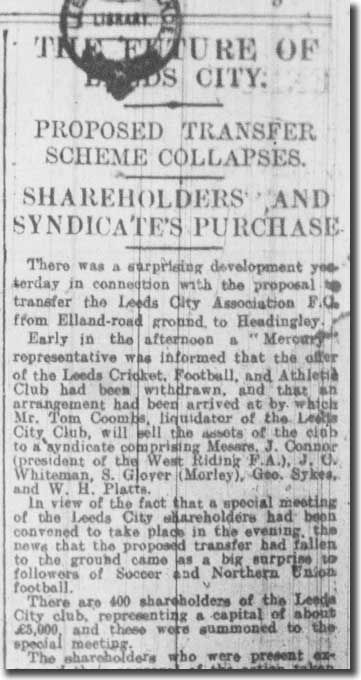 had
thrown plans into disarray. Following the completion of the previous season's
programme, he stated that he could not continue any longer to act in the
capacity of receiver and manager and to continue the club as a business.
had
thrown plans into disarray. Following the completion of the previous season's
programme, he stated that he could not continue any longer to act in the
capacity of receiver and manager and to continue the club as a business.
He had been endeavouring to dispose of the assets of the club on behalf of the debenture holders and yesterday had entered into an agreement for the disposal of those assets.
The shareholders could take on the club on the same terms as syndicate if they wished and could pay the same price. The undertaking which the syndicate had entered into was that the management and other current expenses should be taken over immediately.
Coombs confirmed that under the terms agreed, an unconditional payment of £1,000 was due with immediate effect with a further payment of £250 to follow which was conditional on the receipt by the syndicate of the transfer fees of players who were at the present time on the retain or transfer list of the club. The syndicate would cover all management expenses from the date of the purchase and any existing agreements between the club and the secretary manager, or between the club and any other clubs in reference to provisional transfers. They would also lease the Elland Road ground for a minimum of five years with an option of a further five years, at a rental of £250 a year, and give personal guarantees for the payment of the rent for the first period of five years, with an option to purchase at a price of £5,000.
Alf Masser appealed to shareholders to come forward and help the City club, which, he stated, had suffered from its initiation owing to being governed by an aristocratic body instead of a democratic one. It would have been a calamity had the Association code been allowed to go to Headingley. He was glad that the League Management Committee had insisted that the existing shareholders be consulted before any transfer could take place, an action which was approved by all sportsmen. He was prepared to go to £50 or even more towards the raising of £3,000. He was a lone voice.
Joseph Connor, who was loudly cheered, said that when he and his colleagues approached Coombs, they did so for the good of football and had no intention of making money out of the deal. He thought football ought to take a back seat at the present time, but hoped that when the war was over Leeds City would be a successful organisation.
A resolution was passed to confirm the sale to the syndicate and thanks were given to Connor and his colleagues for the timely steps they had taken in saving the Leeds City Club.
And with that decision the deal was done. Ownership of the club passed to Connor and his compatriots, allowing Coombs to silently take his leave of the spotlight.
Coombs' son, also named Tom, joined his father in the family business as a partner in 1891 and served as Lord Mayor of Leeds in 1936. Both men were leading lights in a local Freemasons' Lodge. The younger man was a vice president of Headingley Rugby Union Football Club and was in later years involved with Leeds United, the successors of the City Club.